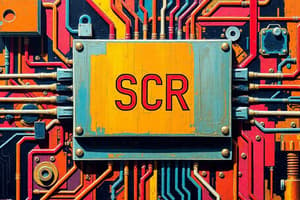Podcast
Questions and Answers
What is the minimum required semiconductor layers to construct a thyristor?
What is the minimum required semiconductor layers to construct a thyristor?
- 3
- 2
- 4 (correct)
- 5
What is the primary function of a thyristor?
What is the primary function of a thyristor?
- Act as an open circuit (correct)
- Act as a closed circuit
- Act as a regulated current source
- Act as a voltage amplifier
What is the term for the value of the anode current at the point where the SUS changes from the forward-blocking region to forward-conducting region?
What is the term for the value of the anode current at the point where the SUS changes from the forward-blocking region to forward-conducting region?
- Switching Current (correct)
- Breakover Voltage
- Holding Current
- Anode Current
What is the method of firing an SUS?
What is the method of firing an SUS?
At dv/dt triggering, what happens to junction 2 in a thyristor when it is in the forward-blocking region?
At dv/dt triggering, what happens to junction 2 in a thyristor when it is in the forward-blocking region?
Flashcards are hidden until you start studying
Study Notes
Thyristors
- Thyristors are constructed using four semiconductor layers (pnpn).
- They include devices such as the 4-layer diode, SCR, diac, triac, SCS, and others.
- Thyristors act as open circuits, capable of withstanding a certain rated voltage until triggered.
- Once triggered, they turn on and become low-resistance current paths, remaining so until the current is reduced to a certain level or until they are triggered off.
Four Layer Diode (Shockley Diode or Silicon Unilateral Switch)
- A type of thyristor constructed from four semiconductor layers.
- SUS Operation:
- Breakover Voltage: minimum forward voltage at which the SUS starts conducting heavily.
- Holding Current: minimum anode current required to maintain the SUS in the on state.
- Switching Current: the value of the anode current at the point where the SUS changes from the forward-blocking region to the forward-conducting region.
Firing an SUS
- Two methods to fire an SUS:
- Supplying a voltage in excess of its breakover voltage.
- Excessive voltage rise in the bias voltage VAK or dv/dt triggering.
- When VAK surpasses the breakover voltage, the SUS saturates and enters the conduction stage.
- The SUS will remain on unless the anode current IA drops below the holding current IH value.
dv/dt Triggering
- At forward-blocking region, the two outer junctions (1 & 3) are forward biased, but the inner junction (2) is reverse biased.
- The reverse-biased junction 2 behaves like a capacitor due to the space-charge present.
- A current will flow in the device to charge the device capacitance.
Studying That Suits You
Use AI to generate personalized quizzes and flashcards to suit your learning preferences.




